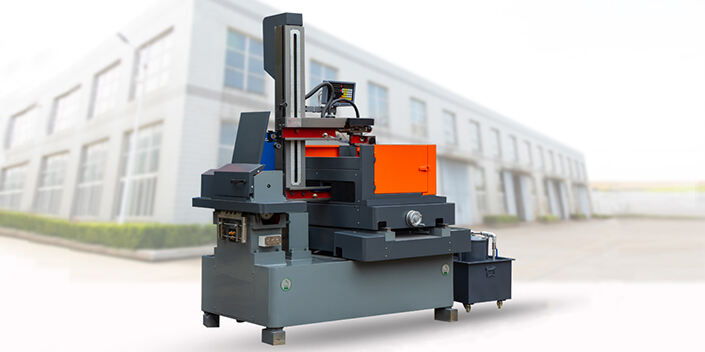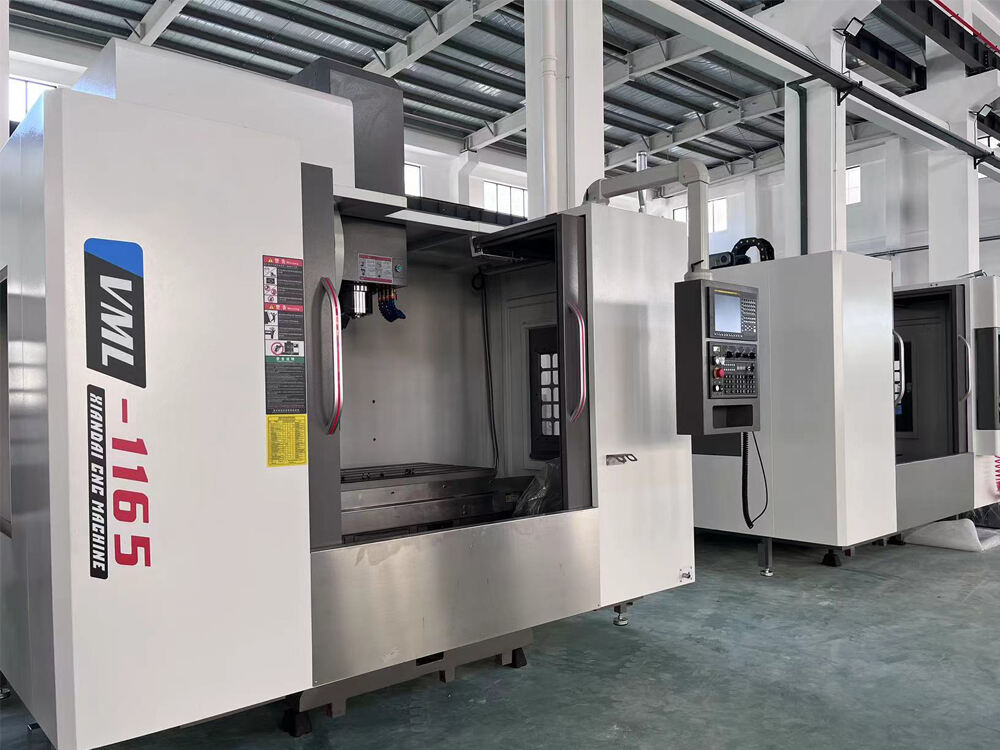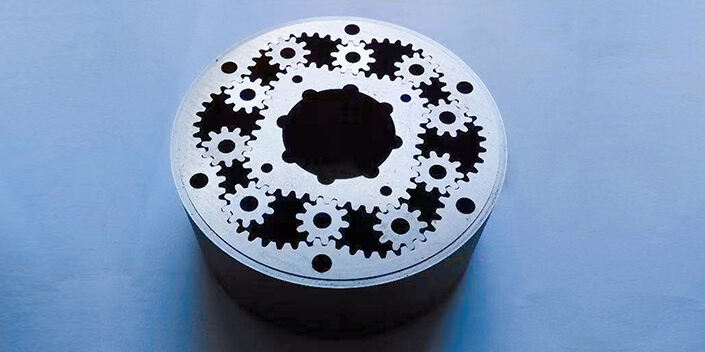הבנה של מכונות קיטוב חשמלי לחתוך מתכת
חיתוך חשמלי בדיסק (EDM) שיטת הקיטוב החשמלי, הידועה גם בשם Sinker EDM, היא תהליך המשתמש בשחרור חשמלי כדי לחותך את המתכות בצורה מדויקת. טכניקה זו במיוחד בלתי נפרדת לבניית צורות מסובכות ומעיינות בחומרים שקשה להכין אותם באמצעות שיטות קונבנציונליות. הפונקציה המרכזית של הקיטוב החשמלי לחתוך מתכת היא לספק דיוק גבוה ופרטים ברכיבים, מה שגורם לו להיות אידיאלי לתעשיות שדורשות סובלנות מינימלית, כמו תעופה, רכב, ואלקטרוניקה.
המרכיבים היסודיים של מכונה לחתיכת מתכת על ידי תהליך EDM כוללים אלקטרודות וסוגים שונים של נוזל דיאלקטרי, כל אחד מהם מילא תפקיד קריטי בתהליך החיתוך. חומרי האלקטרודה, שמתוכם רבים עשויים מגרפיט או נחושת, פועלים ככלי שיוצר את צורתו של חלק המתכת. האלקטרודה, שנמצאת מתחת לפני השטף הדיאלקטרי, תומכת בתהליך השחרור על ידי העצמה בין האלקטרודה והחלק, אך מאפשרת את ייצור ההבזקים במתח גבוה. לפי מחקר שפורסם בכתב העת "علوم שימושיות", "תהליכי EDM, כולל חיתוך מתכת, תלויים מאודenschaftים של האלקטרודות והנוזל הדיאלקטרי כדי להשיג הסרה יעילה של חומר" (קודאירי ועמיתים, 2020). הקומבינציה הזו מאפשרת ל-EDM לבצע חיתוך ויצירת רכיבים עם פרטים מסובכים ללא מגע ישיר, מה שמבטל את התENSION המכנית על החומר.
השפעת חומרים חדשים על יציקת מכונות חיתוך מתכת באמצעות תהליך EDM
בחירת החומר משחקת תפקיד קריטי בהצלחת פעולות EDM Die Sinking, להשפיע ישירות על דיוק ההרכבה ועל איכות המוצר הסופי. בחירת החומרים משפיעה על הולכת החשמל והמאפיינים התרמיים, מה שבעורם משפיע על יעילות תהליך ה-EDM. למשל, שימוש בחומרי קוטב באיכות גבוהה כמו נחושת יכול לשפר את דיוק ההרכבה因为 להולכת החום והחשמל המצוינת שלו. מנגד, בחירת חומרים אינферיאוריים עלולה לגרום להגדלת ה摩טש וההיזק, מה שיביא להפחתת האיכות והדיוק של המרכיבים שהוכנו.
התפתחות החומרים שמשתמשים בהם בתהליכי EDM השפיעה באופן משמעותי על יעילותם וסיבוכיותם הכלכליים של הפעולות. בעבר, חומרים כמו גרףיט ונחושת היו מועדפים בשל תכונותיהם החשמליות העצמיות. עם זאת, חומרים חדשים בעלי מבנים מיקרוסקופיים משופרים, כמו תרכובות גרפיט מתקדמות ומתloys מתכתים, הראו ביצועים עולים. חומרים מודרניים אלו מאפשרים מהירויות חיתוך מהירות יותר וזמני עיבוד קצרים יותר, מה שמצמצם את ההוצאות. למשל, נתונים אחרונים מראים כי שימוש בחומרים אולטרה-דקיקים יכול להעלות את מהירות החיתוך עד 15%, בהשוואה לחומרים סופר-דקיקים קונבנציונליים.
מחקריםurnished ראיות אמפיריות לשיפורים ש isEnabledו על ידי טכנולוגיות חומרים חדשות ב-EDM. מחקר השוואה בין חומרי קוטב סופר דק ועל דק גילה הבדל מובהק באיכות מסי הפנים ובזמן התהליך הכולל. החומרים העל דקים השיגו מסה יוצאת מן הכלל של 27 VDI, בעוד שהחומרים הסופר דקים הגיעו בלבד ל-31 VDI, מה שדורש עיבוד נוסף.ßerdem, זמן תהליך ה-EDM נחתך ב-15% כאשר נעשה שימוש בחומרים על דקים, מה שמצביע על חיסכון משמעותי בהוצאות ייצור והיענות זמן.
חקירת התקדמות🙂ديثה בחומרים ל-EDM
התפתחויות אחרונותlatesrecent ב质חומרים ל-EDM הביאו לשימוש בחומרים חדשניים כמו תרכובות גרפיט ועloys מיוחדים. החומרים האלה הפכו לחשובים מאוד בتطبيقات EDM בגלל התכונות הייחודיות שלהם שמשמשות את הדרישות המורכבות של התעשייה. תרכובות גרפיט מציעות הנדסת חשמלית יוצאת דופן והיציבות התרמית, מה שמאפשר להם להיות מושלמים לתהליכי EDM ביצועים גבוהים. באופן דומה, עloys מיוחדים מספקים התנגדות למתלה משופרת ואריכות חיים, מפחיתים את תדירות החלפות חלקים והפסקות.
אינטגרציה של חומרים מודרניים ב-EDM מובילה להתקדמות משמעותית ביצועים, כולל עמידות כלים ארוכה יותר, יציבות תרמית מופרת ותדמית חשמלית משופרת. התקדמות זוtributes ל процесי חיתוך יעילים ומדויקים יותר. למשל, ספוגים מסיסי נחושת הם ידועים בהולכת החום המצוינת שלהם, שמבטיחה התפשטות חום מהירה יותר ודיוק מימדי משופר. מאפיינים אלו הם קריטיים כדי להשיג תוצאות חיתוך רצויות, כפי שנראה במחקרים אחרונים על יישומי EDM.
היתרהועות עולם-אמתי של חומרים מודרניים אלו נתמכים על ידי דעות של מומחים ומחקרים מובנים. למשל, מחקר על השימוש באלומיניום חזק במיוחד ב-EDM מראה שיפור בשיעורי הסרת החומר והפחתת ה摩טציה של הכלים בהשוואה לחומרים מסורתיים. מומחי התעשייה רואים את ההנחות הללו בעין, מה שמביא להכרה רחבה יותר וביצועים של חומרים חדשניים במערכת EDM. לכן, ההתפתחות של החומרים המשמשים במכונה של פליטת חשמל מוסיפה תפקיד מרכזי בהתקדמות האפקטיביות והאיכותה של התהליך.
נקודות מפתח להתחשבות בתאימות חומרים ב-EDM
תאימות חומרים בחתיכת חשמל (EDM) היא דבר חיוני, במיוחד בהתייחסות לולחידות. הולחידות משפיעה ישירות על העברת אנרגיה ובכך, על יעילות תהליך החיתוך. הולחידות האופטימלית מבטיחה זרימת אנרגיה חלקה במהלך החיתוך, מה שגורם להחתכים והסיומים להיות מדויקים. למשל, גרפיט ונחושת הם חומרים מועדפים לשימוש כאלקטרודות ב-EDM בשל הולחידות הגבוהה שלהם, המאפשרת ייצור פיסות חשמליות יעילות והסרת חומר אפקטיבית.
עמידות ומדדי הביצועים של חומרים משתנים ומשפיעים בצורה ניכרת על תפוקת הייצור בתהליכי EDM. חומרים שונים מציגים תכונות ייחודיות שקובעות את התנגדות ההעתקה והאריכות חייהם במהלך החיתוך. למשל, קרביד ופלדה מחוזקת, שידועים בעמידותם, הם מתאימים עבור ריצי ייצור גדולים מכיוון שהם견חים מספר רב של פעולות EDM ללא הרס משמעותי. העמידות הזו גורמת להקטנת זמן עצירה ותוספת יעילות בייצור.
מומחים בתעשייה ויצרני מכונות מובילים מדגישים את חשיבות בחירת חומרים על סמך מאפיינים מסוימים כמו מוליכות והחזקה. למשל, כפי שמשווק על ידי יצרני מכונות EDM המובילים, נחושת-טונגסטן וכסף-טונגסטן נחשבים ל-materials מועדפים עבור תחומים המבקשים גם מוליכות גבוהה וגם התנגדות להיזון. המלצות אלו על חומרים מבטיחות שהתהליכים של חיתוך יישארו יעילים ויביאו לתוצאות באיכות גבוהה, מתאימות לסטנדרטים התעשיתיים של חזק ודיוק.
הגרות ושיטות פתרון ב-CNC EDM עם חומרים חדשים
בעת trabalhando com materiais novos em Usinagem por Descarga Elétrica (EDM), vários desafios podem surgir, incluindo desgaste e degradação da ferramenta. Esses problemas são principalmente devidos à abrasividade e à dureza dos materiais, que podem acelerar o desgaste e levar a quebras frequentes das ferramentas. Por exemplo, cerâmicas avançadas e materiais compostos são difíceis de usinar usando métodos convencionais, o que resulta em taxas de desgaste aumentadas e na redução da vida útil da ferramenta.
Para enfrentar esses desafios, várias técnicas podem ser empregadas. A adaptação dos parâmetros de usinagem, como ajustar a corrente de descarga elétrica e a duração do pulso, pode reduzir significativamente o desgaste. Além disso, o desenvolvimento de designs avançados de ferramentas, como fios revestidos ou ferramentas com propriedades térmicas aprimoradas, pode ajudar a mitigar o desgaste e melhorar a eficiência do processo de usinagem. Tais avanços garantem que as ferramentas possam suportar as condições severas apresentadas pelos novos materiais.
נתוני סטטיסטיקה מראים שהחומרים חומרים מסורתייםโนוטים נוטים להפגין שיעורי כשל גבוהים יותר בהשוואה לחומרים מוגדרים מהנדסיים חדשים כאשר הם מעובדים באמצעות EDM. מחקר הראה כי שימוש בחומריםposite יכול לצמצם את שיעורי הכשל עד ל-30% כאשר משולבים עם פרמטרי עיבוד מופתמים [מקור: כתב העת ליצירתיות וטכנולוגיה]. השוואה זו מדגישה את הצורך לפתח את שיטות החיתוך והעיצוב של ציוד כדי להתמודד עם האתגרים השונים שמוצגים על ידי חומרים חדשניים בתהליכי EDM.
מגמות עתידיות בטכנולוגיות שקיעת Electro Discharge Machining (EDM)
טכנולוגיות נוותרות במכירת חשמל (EDM), כמו אינטגרציה של אוטומציה ומעקב המבוסס על AI, מוכנות להגדיר מחדש את תקן ההיעילות בתעשייה. האוטומציה מאפשרת פעולות חלקות עם פיקוח ידני מופחת, מה שמשפר את עקביות התפוקה. בינתיים, מערכות המבוססות על AI מספקות מעקב בזמן אמת ויכולות תחזית תקלה, כדי לוודא שהпроcedures מופתמים והזמן מתوقف מופחת.
חומרים מתקדמים מוכנים להשפיע באופן משמעותי על תהליכי EDM, במיוחד בהרחבת ההזד הזמנויות לצורה אישית וamodeling מהיר. החומרים האלה לא רק מציעים תכונות יוצאות מן הכלל כמו קושי גבוה יותר ואיצון תרמי, אלא גם מביאים את הפוטנציאל לביצוע תצורות חדשניות שאינן זמינות בחומרים מסורתיים.
דיווחים של התעשייה מנבאים צמיחה משמעותית בהאימוץ של טכנולוגיות EDM בsectors כמו תעופה ומכשירי רפואי. חלוצי העתיד כמו בריאן סוליס ממליצים שהתעשייה עלולה להשיג שיעור צמיחה שנתי מחושב של 6.2%, מונע על ידי הביקוש לייצור חלקים מורכבים. הסקירות הללו מצביעות על עתיד מבטיח לטכנולוגיות EDM כאשר הן מתפתחות כדי לענות על האתגרים וההזד הזדמנויות שהנובעים ממATERIALS חדים-קצוות וצרכי תעשייה.





